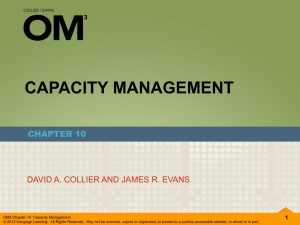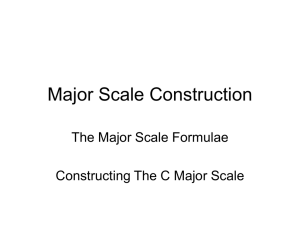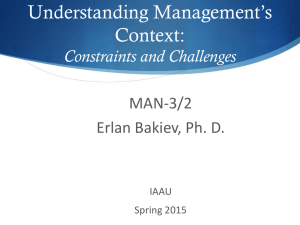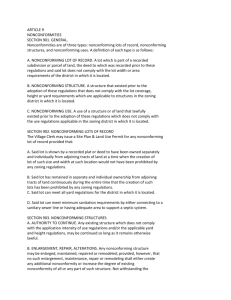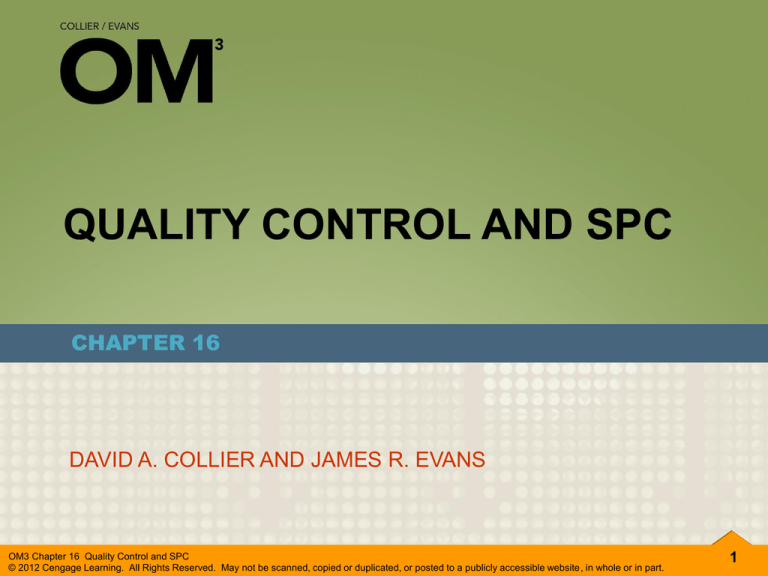
QUALITY CONTROL AND SPC
CHAPTER 16
DAVID A. COLLIER AND JAMES R. EVANS
OM3 Chapter 16 Quality Control and SPC
© 2012 Cengage Learning. All Rights Reserved. May not be scanned, copied or duplicated, or posted to a publicly accessible website, in whole or in part.
1
Statistical Process Control and Variation
• Statistical process control (SPC) is a
methodology for monitoring quality of
manufacturing and service delivery processes
to help identify and eliminate unwanted
causes of variation.
2
Statistical Process Control and Variation
• Common cause variation is the result of
complex interactions of variations in materials,
tools, machines, information, workers, and the
environment.
Common cause variation accounts for 80 to 95
percent of the observed variation in a process.
Only management has the power to change
systems and infrastructure that cause common
cause variation.
3
Statistical Process Control and Variation
• Special (assignable) cause variation arises
from external sources that are not inherent in the
process, appear sporadically, and disrupt the
random pattern of common causes.
Special cause variation accounts for 15 to 20
percent of observed variation.
Front-line employees and supervisors have the
power to identify and solve special causes of
variation.
4
Statistical Process Control and Variation
• If no special causes affect the output of a
process, we say that the process is in control.
• When special causes are present in a process,
the process is said to be out of control.
5
Constructing Control Charts
1. Preparation
a. Choose the metric to be monitored.
b. Determine the basis, size, and frequency of
sampling.
c. Set up the control chart.
2. Data collection
a. Record the data.
b. Calculate relevant statistics: averages, ranges,
proportions, and so on.
c. Plot the statistics on the chart.
6
Constructing Control Charts
3. Determination of trial control limits
a. Draw the center line (process average) on the
chart.
b. Compute the upper and lower control limits.
4. Analysis and interpretation
a. Investigate the chart for lack of control.
b. Eliminate out-of-control points.
c. Recompute control limits if necessary.
7
Constructing Control Charts
5. Use as a problem-solving tool
a. Continue data collection and plotting.
b. Identify out-of-control situations and take
corrective action.
6. Determination of process capability using the
control chart data
8
Constructing Control Charts
• A continuous metric is one that is calculated
from data that are measured as the degree of
conformance to a specification on a continuous
scale of measurement.
• A discrete metric is one that is calculated from
data that are counted.
9
Constructing x- and R-Charts
• Collect k = 25-30 samples of n = 3-10 observations
each.
• Compute the mean and range of each sample.
• Compute the overall mean and average range:
[16.1]
[16.2]
• Compute the control limits:
[16.3]
10
Solved Problem
Goodman Tire periodically tests its tires for tread
wear under simulated road conditions. The
company collects twenty samples, each containing
three radial tires from different shifts over several
days of operations. The overall mean is computed
as 31.88, and the average range is 10.8.
11
Exhibit 16.1 Excel Template for Goodman Tire x-bar and R-Charts
12
Solved Problem
Control limits are:
13
Exhibit 16.2 R-Chart for Goodman Tire Example
14
Exhibit 16.3 x-Chart for Goodman Tire Example
15
Interpreting Patterns in Control Charts
A process is said to be “in control” when the control
chart has the following characteristics:
1. No points are outside the control limits (the
traditional and most popular SPC chart guideline).
2. The number of points above and below the center
line is about the same.
3. The points seem to fall randomly above and below
the center line.
4. Most points, but not all, are near the center line, and
only a few are close to the control limits.
16
Interpreting Patterns in Control Charts
Rules for identifying a shift in the process:
• 8 points in a row above or below the center line.
• 10 of 11 consecutive points above or below the center
line.
• 12 of 14 consecutive points above or below the center
line.
• 2 of 3 consecutive points in the outer one-third region
between the center line and one of the control limits.
• 4 of 5 consecutive points in the outer two-thirds region
between the center line and one of the control limits.
17
Exhibit Extra Illustration of Some Rules for Identifying Out-of-Control Conditions
18
Constructing p-Charts
• A p-chart monitors the proportion of
nonconforming items (also called a fraction
nonconforming or fraction defective chart).
• pi is the fraction nonconforming in sample i.
• Average fraction nonconforming:
[16.4]
• Standard deviation:
[16.5]
19
Constructing p-Charts
Control limits:
[16.6]
20
Solved Problem
The operators of automated sorting machines in a post office must
read the ZIP code on letters and divert the letters to the proper
carrier routes. Over a month’s time, 25 samples of 100 letters
were chosen, and the number of errors was recorded.
The average proportion defective, p is computed as 0.022. The
standard deviation is:
UCL = .022 + 3(.01467) = .066, and LCL = .022 - 3(.01467) =
-.022. Since the LCL is negative and the actual proportion
nonconforming cannot be less than zero, the LCL is set equal to
zero.
21
Exhibit 16.4
Data and Calculations
for the p-Chart Solved
Problem
22
Exhibit 16.5 p-Chart for Solved Problem
23
Constructing c-charts
•
A c-chart monitors the number of nonconformances (i.e., a count of the
number of defects or errors) per unit, when the size of the sampling unit or
number of opportunities for errors is constant.
•
Example: A purchase order may have several errors, such as wrong
items, order quantity, or wrong price.
c is the average number of nonconformances/unit. Control limits are given
by:
UCLc = c + 3 √ c
[16.7]
LCLc = c - 3 √ c
24
Solved Problem
The total number of machine failures over a 25-day
period is 45.
The average number of failures per day, c, is 45/25
= 1.8.
Control limits for the c-chart are:
25
Exhibit 16.6
Machine Failure
Data for c-Chart
Solved Problem
26
Exhibit 16.7 c-Chart for Machine Failures
27
Practical Issues in SPC Implementation
• Sample size: Small sample size keeps costs
lower; however, large sample sizes provide
greater degrees of statistical accuracy in
estimating the true state of control.
• In practice, samples of about 5 have been found
to work well in detecting process shifts of 2
standard deviations or larger. To detect smaller
shifts in the process mean, larger sample sizes of
15 to 25 must be used.
28
Controlling Six Sigma Processes
• SPC is a useful methodology for processes that
operate at a low sigma level (less than or equal
to 3-sigma).
• For processes with a high sigma level (greater
than 3-sigma), few defects will be discovered
even with large sample sizes.
• More advanced tools are necessary.
29
Process Capability
•
•
Process capability refers to the natural variation in a process
that results from common causes.
A process capability study is a carefully planned study
designed to yield specific information about the performance
of a process under specified operating conditions.
Typical questions:
Where is the process centered?
How much variability exists in the process?
Is the performance relative to specifications acceptable?
What proportion of output will be expected to meet
specifications?
30
Process Capability Index
The relationship between the natural variation and
specifications is often quantified by a measure known as
the process capability index.
Cp = (UTL – LTL)
6σ
[16.9]
Where:
UTL = Upper tolerance limit
LTL = Lower tolerance limit
σ = Standard deviation of the process (or an estimate
based on the sample standard deviation, s)
31
Process Capability Index
• When Cp = 1, the natural variation is the same as
the design specification width.
• When Cp < 1, a significant percentage of output
will not conform to the specifications.
• When Cp > 1, nearly all the output will conform
to the specifications.
32
Exhibit 16.8 c-Process Capability versus Design Specifications
33
Process Capability Index
• Many firms require Cp values of 1.66 or greater from
their suppliers, which equates to a tolerance range of
about 10 standard deviations.
• The value of Cp does not
depend on the mean of the
process (it depends on the
specification range and actual
process standard deviation);
thus, a process may be offcenter, and still show an
acceptable value of Cp.
34
Process Capability Index
One-sided process capability indexes consider offcentering in a process:
Cpu = (UTL – µ)/3σ (upper one-sided index) [16.10]
Cpl = (µ – LTL)/3σ
Cpk = min (Cpl, Cpu)
(lower one-sided index)
[16.11]
[16.12]
35
Solved Problem
A controlled process shows an overall mean of 2.50
and an average range of 0.42. Samples of size 4
were used to construct the control charts. If
specifications are 2.60 ± 0.25, how well can this
process meet them? What are the process
capability indexes?
36
Solution
• UTL = 2.60 + 0.25 = 2.85
• LTL = 2.60 – 0.25 = 2.35
• We estimate the standard deviation using
equation 16.8. From Appendix B, d2 = 2.059 and
s = R/d2 = 0.42/2.059 = 0.20.
• Actual process performance is 2.50 ± 3(0.20), or
ranges from 1.90 to 3.10. This variation exceeds
the specifications by a large amount and is also
off-center.
37
Exhibit 16.9 Comparison of Observed Variation and Design Specifications
for Solved Problem
38





